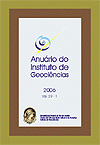Multi-scale analysis of sedimentary attributes of paleogene fluvial deposits from the Volta Redonda Basin, RJ
DOI:
https://doi.org/10.11137/2006_2_168-198Abstract
This study aims to perform a multi-scale analysis of the sedimentary attributes presented by Paleogene fluvial deposits of the Volta Redonda Basin (Continental Rift of Southeastern Brazil), including the characterization of sedimentary facies, depositional architecture and petrographical features. The results from this study may be applied to the modelling of fluid behaviour inside fluvial reservoir-rocks. Among the studied deposits are the main aquifers of the sedimentary basins which compose the Continental Rift of Southeastern Brazil. The methodologic framework comprised: interpretation of an outcrop by using a photomosaic to the recognition of depositional architecture, emphasizing the stratigraphic surface hierarchy; facies characterization with vertical profiles; and petrographic analysis of selected samples. Two distinct facies associations were recognized, corresponding to Resende and Pinheiral formations. The Resende Formation deposits present a simple complexity heterogeneity style, with a wide lateral continuity. They are composed by decimetric layers of massive sandstones interbedded to clayey sandstones, showing a tabular geometry and few dozen-meters width. The contacts between these deposits are gradual. The Pinheiral Formation deposits present a medium complexity heterogeneity style, exhibiting frequent truncation of architectural elements, characterized by decimetric and dozen-meters width sandy layers with conglomeratic levels interbedded to thin pelitic intervals. These deposits present a extended lenticular geometry and irregular contacts. Microscopically, sandstones from Resende Formation present low porosity, related to the occurrence of clayey matrix resulted from feldspars alteration. The sandstones from Pinheiral Formation show porosities similar to reservoir patterns.Downloads
Download data is not yet available.
Downloads
Published
2006-01-01
How to Cite
Marques, C. C. S., Mello, C. L. and Ramos, R. R. C. (2006) “Multi-scale analysis of sedimentary attributes of paleogene fluvial deposits from the Volta Redonda Basin, RJ”, Anuário do Instituto de Geociências. Rio de Janeiro, BR, 29(2), pp. 168–198. doi: 10.11137/2006_2_168-198.
Issue
Section
Article
License
This journal is licensed under a Creative Commons — Attribution 4.0 International — CC BY 4.0, which permits use, distribution and reproduction in any medium, provided the original work is properly cited.















